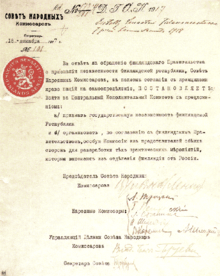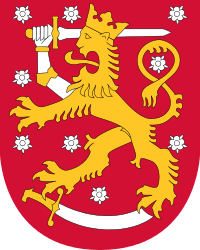Finnish Declaration of Independence



The Finnish Declaration of Independence (Russian: Провозглашение независимости Финляндии; Finnish: Suomen itsenäisyysjulistus; Swedish: Finlands självständighetsförklaring) was adopted by the Parliament of Finland on 6 December 1917. It declared Finland an independent nation, among nations ending its autonomy within Russia as its Grand Duchy of Finland, with reference to a simultaneously delivered bill to the Diet to make Finland an independent republic instead.
Birth of a nation

Before a nation declares independence, it must develop a national identity and certain institutions. Governing bodies for Finland were developed after 1809, when it was “elevated as a nation among nations” (as declared by tsar Alexander) by becoming an autonomous grand duchy under the Russian tsar. The Diet of Finland was meeting regularly since 1863. In 1906 the unicameral Parliament of Finland was created, with universal and equal suffrage.[1]
National identity grew at same time with Pan-European nationalism. Johan Ludvig Runeberg and Elias Lönnrot created an idealized image of Finnish people and Finnish nature in the 1830s and 1840s.[2] Also J. V. Snellman was a central person in national romanticism and the modern nationality debate. He encouraged use of Finnish language (instead of Swedish) among the educated classes.[3]
Second period of Russification of Finland and World War I got different activist groups to unite. Jäger Movement sent first 200, later 1900 volunteers to Germany to be trained as Jägers (elite light infantry), for armed resistance.[4]
Revolution in Russia
The February and the October Revolution in 1917, had also ignited hopes in the Grand Duchy of Finland. After the abdication of Grand Duke Nicholas II on 15 March 1917, the personal union between Russia and Finland lost its legal base – at least according to the view in Helsinki. There were negotiations between the Russian Interim Government and Finnish authorities.
The resulting proposal, approved by the Interim Government, was heavily rewritten in the Parliament and transformed into the so-called Power Act (Finnish: Valtalaki, Swedish: Maktlagen), whereby the Parliament declared[5] itself to now hold all powers of legislation, except with respect to foreign policy and military issues, and also that it could be dissolved only by itself. At the time of the vote it was believed that the Interim Government would be quickly defeated. The Interim Government survived, however, disapproved of the Power Act and dissolved the Parliament.
After new elections and the ultimate defeat of the Interim Government, on 5 November, the Parliament declared itself to be "the possessor of supreme State power" in Finland, based on Finland's Constitution, and more precisely on §38 of the old Instrument of Government of 1772, which had been enacted by the Estates after Gustav III's bloodless coup. This paragraph provided for the election of a new monarch in case of the extinction of the royal line and was interpreted in Finland as vesting sovereignty in the estates, later the Parliament, in such an interregnum.
On 15 November 1917, the Bolsheviks declared a general right of self-determination, including the right of complete secession, "for the Peoples of Russia". On the same day the Finnish Parliament issued a declaration by which it assumed, pro tempore, all powers of the Sovereign in Finland.[6]
The old Instrument of Government was however no longer deemed suitable. Leading circles had long held monarchism and hereditary nobility to be antiquated, and advocated a republican constitution for Finland.
The Senate of Finland, the government the Parliament had appointed in November, came back to the Parliament with a proposal for a new republican Instrument of Government on 4 December. The Declaration of Independence was technically given the form of a preamble of the proposition, and was intended to be agreed by the Parliament. Parliament adopted the Declaration on 6 December.
On 18 December (31 December N. S.) the Soviet Russian government issued a Decree, recognizing Finland's independence,[7] and on 22 December (4 January 1918 N. S.) it was approved by the highest Soviet executive body, the All-Russian Central Executive Committee (VTsIK).[8]
The Declaration and 15 November


With reference to the declaration of 15 November, the declaration says:
The people of Finland have by this step taken their fate in their own hands; a step both justified and demanded by present conditions. The people of Finland feel deeply that they cannot fulfil their national and international duty without complete sovereignty. The century-old desire for freedom awaits fulfilment now; Finland's people step forward as a free nation among the other nations in the world. (...) The people of Finland dare to confidently await how other nations in the world recognize that with their full independence and freedom, the people of Finland can do their best in fulfilment of those purposes that will win them a place amongst civilized peoples.
Context
Estonia, Latvia, Lithuania declared their independence from Russia during the same period. See Estonian War of Independence, Latvian Independence and Lithuanian Wars of Independence.
These three countries were occupied by, and annexed into, the Soviet Union (1940-1941, 1944-1991). See Occupation of the Baltic states.
Text of Finland's Declaration of Independence
To The Finnish People.At the Finnish Parliament session today, has the Finnish Senate by its chairman forwarded to the Diet, among other things, a Proposition for a new form of government for Finland. By submitting the draft to the Parliament, has the Finnish Senate chairman on behalf of the Finnish Senate stated:
The Finnish Parliament has on 15th day of the last November, in support of Section 38 of the Constitution, declared to be the Supreme holder of the State Authority as well as set up a Government to the country, that has taken to its primary task the realization and safeguarding Finland’s independence as a state. The people of Finland have by this step taken their fate in their own hands: a step both justified and demanded by present conditions. The people of Finland feel deeply that they cannot fulfil their national duty and their universal human obligations without a complete sovereignty. The century-old desire for freedom awaits fulfilment now; The People of Finland has to step forward as an independent nation among the other nations in the world.
Achieving this goal requires mainly some measures by the Parliament. Finland’s current form of government, which is currently incompatible with the conditions, requires a complete renewal and therefore has the Government now submitted a proposition for a new Constitution to the Parliament’s council, a proposition that is based on the principle that Finland is to be a sovereign republic. Considering that, the main features of the new polity has to be carried into effect immediately, the Government has at the same time delivered a bill of acts in this matter, which mean to satisfy the most urgent renewal needs before the establishment of the new Constitution.
The same goal also calls for measures from the part of the Government. The Government will approach foreign powers to seek an international recognition of our country’s independence as a state. At the present moment this is particularly all the more necessary, when the grave situation caused by the country’s complete isolation, famine and unemployment compels the Government to establish actual relations to the foreign powers, which prompt assistance in satisfying the necessities of life and in importing the essential goods for the industry, are our only rescue from the imminent famine and industrial stagnation.
The Russian people have, after subverting the Tsarist Regime, in a number of occasions expressed its intention to favour the Finnish people the right to determine its own fate, which is based on its centuries-old cultural development. And widely over all the horrors of the war is heard a voice, that one of the goals of the present war is to be, that no nation shall be forced against its will to be dependent on another (nation). The Finnish people believe that the free Russian people and its constitutive National Assembly don’t want to prevent Finland’s aspiration to enter the multitude of the free and independent nations. At the same time the People of Finland dare to hope that the other nations of the world recognizes, that with their full independence and freedom the People of Finland can do their best in fulfilment of those purposes that will win them an independent position amongst the people of the civilized world.
At the same time as the Government has wanted to let all the Finnish citizens to know these words, the Government turns to the citizens, as well as the private and public authorities, calling everyone on their own behalf with rapt attention to follow the (law and) order by filling their patriotic duty, to strain all their strength for achieving the nations common goal in this point of time, which has such an importance and decisiveness, that there have never before been in the life of the Finnish people. In Helsinki, 4 December 1917.
The Finnish Senate:
P.E. Svinhufvud. E.N. Setälä.
Kyösti Kallio. Jalmar Castrén.
Onni Talas. Arthur Castrén.
Heikki Renvall. Juhani Arajärvi.
Alexander Frey. E.Y. Pehkonen.
O.W. Louhivuori.[9]
International recognition
Organizing a new country
Hardship burdened the common people, which already had resulted in alarming polarization, and soon would ignite the Civil War. The declaration actually addresses this problem:
The Government will approach foreign powers to seek the recognition of our political independence. All the complications, famine and unemployment ensuing from the present external isolation make it urgent for the Government to tie direct contacts with foreign powers without delay. Urgent, concrete assistance in the form of necessities for living and industry is our only rescue from imminent famine and industrial standstill.
The attempt to establish a monarchy in Finland was not successful, and 1919 Kaarlo Juho Ståhlberg became the first president. First parliament elections were held in March 1919.
National symbols

The parliament selected among several suggestions a blue and white flag, and the new flag of Finland was rising over house of parliament 28 May 1918.[10] Coat of arms of Finland with crowned lion on a red field had been used already in years of Swedish rule.[11]
Commemoration
6 December was later declared as the national holiday Finland Independence Day. The bill to make Finland a republic was ultimately passed by the Diet in 1919.
The 90th Anniversary of Finland's Declaration of Independence was selected as the main motif for the €5 90th Anniversary of Finland's Declaration of Independence commemorative coin, minted in 2007. The reverse shows petroglyph aesthetics, while the obverse has a nine-oar boat with rowers as a symbol of collaboration. Musical symbols and Finnish zitherin strings are also distinguishable in the coin's design.
See also
References
- ↑ "Parliamentarism in Finland". Finland.fi. Retrieved 12 June 2016.
- ↑ Matti Klinge. "Runeberg, Johan Ludvig (1804 - 1877)". The National Biography of Finland. Retrieved 12 June 2016.
- ↑ Klinge, Matti. "Snellman, Johan Vilhelm (1806 - 1881)". The National Biography of Finland. Retrieved 12 June 2016.
- ↑ "The Finnish Jaeger Movement". Embassy of Finland, Riga.
- ↑ Valtalaki "Hallituksen esitykseen, joka sisältää ehdotuksen laiksi erinäisten asiain siirtämisestä Suomen senaatin ja kenraalikuvernöörin ratkaistavaksi" Check
|url=value (help) (in Finnish). 25 July 1917. Retrieved 8 February 2014. - ↑ "Eduskunta". Suomi 80 (in Finnish). Tampere University. Retrieved 20 August 2016.
- ↑ "Primary Documents - Soviet Recognition of Finland's Independence, 18 December 1917". first world war. Retrieved 20 August 2016.
- ↑ "On This Day - 4 January 1918". first world war. Retrieved 20 August 2016.
Eastern front: Bolshevik Government recognises independence of Finland.
- ↑ Translation from the Finnish language by B.Holm, 25 July 2009. (Clarifications by the translator are in brackets.)
- ↑ "Quirks of history: Finnish flag created in a restaurant back room?". Suomifinland100. Retrieved 12 June 2016.
- ↑ http://finland.fi/life-society/coat-of-arms/
External links
- Declaration of independence (Finnish) from Wikisource
- Declaration of independence (Swedish) from Wikisource
- Instrument of Government (Swedish) from Wikisource
- Audio recording of Svinhufvud reading the speech in 1937 from YLE
